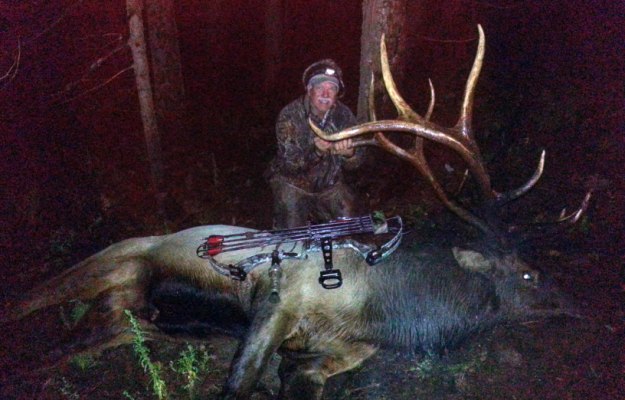
The last bull elk I shot was in 2014, also in Unit 27. Our elk season that year opened on a Friday, and it rained solid from Friday morning until Tuesday afternoon. I got cabin fever really bad and couldn’t stand being in my camper all that time.
I've taught bowhunter education for several years. I teach that rarely, if ever, do you want to bowhunt in the rain, because the rain can change the trajectory of the arrow flight. The rain can also wash away a blood trail, and you can’t see or hear very well when the rain is coming down. However, sitting in my camper for five days waiting on the rain to stop was more than I could handle. So, I put on my rain suit and got ready to leave. My hunting buddy, Henry Zipf, decided he wouldn’t go out in that rain to hunt an elk.
I drove to the area where I was going to hunt, parked my truck, walked about 100 yards and jumped three bulls. I cow called a couple of times to them. Before I left my truck, I’d put a diaphragm cow call in my mouth, where I planned to keep it until I left the woods and returned to my truck. The three bulls I called to stopped, and I had a fourth bull bugle down the canyon from me. Then off to my left about 120 yards, I heard a fifth bull bugle. When both bulls bugled a second time from the same spot they had bugled the first time, I decided those bulls were bedded down. With rain falling, I thought I’d try to sneak in and see how close I could get to one of those bulls. I knew that the rain would muffle the sound of me walking, and the rain hitting the leaves would somewhat camouflage my movements.
One big bull and two smaller bulls were in the area where I was making my stalk. I'm not a horn hunter. If a small bull gives me a better shot than a big bull, I’ll take the smaller bull. I moved to within 53 yards of the bulls and identified a tall, burnt stump I could stand behind. I knew I could make that 53-yard shot. I drew my bow and stepped out from behind the stump, after lining up my shot. But a tree blocked my arrow from the bull’s vitals. So, I eased back behind the stump, let my bow down and waited.
This bull and the bull farther down in the canyon exchanged bugles a couple of times. Finally, the bull I was planning to take got up and walked off, but I could see that two nice bulls were still bedded down. While waiting on one of the smaller bulls to stand up so I could get a shot, the really big bull down in the canyon bugled. The other bull that had gotten up and walked off returned to where he’d been bedding and presented a broadside shot at 35 yards. I had drawn my bow when I heard him bugle and started coming back to where he had been bedded. When he walked into one of the shooting lanes where I had planned to take the shot, he looked straight at me and I released the arrow. The bull was slightly quartering to me, but I hit him right behind the shoulder. After he took the arrow, he only went 10 yards before he went down.
His net score was 330 inches. I’d parked my camper at Henry’s cabin, 25 minutes away from where the bull had fallen. I returned to my camper and got my frame pack, knives and other equipment I needed to field dress the animal. Henry agreed to go back with me and help me carry the meat and the head out. When we reached the elk, I got the cape and the head. Then we saddle bagged the hindquarters and the shoulders. I cut the two hindquarters off the backside of the elk, left the skin behind the hindquarters and the legs attached to the skin. This way, I could put two hindquarters on my back and hold on to both legs and carry the hindquarters out. We used the same technique to get the front quarters out. We took out the backstraps and the tenderloins, too. Finally, we deboned the neck and any other meaty parts of the elk and put that meat in a game bag, which we called the trim bag. Usually, the trim bag is the heaviest bag to carry out. Since we didn’t have but about a quarter-mile to go, I split the hind and front quarters, and Henry and I made about six trips back and forth to get the elk out.
Day 1: Mark Hanson’s Biggest Arizona Bull Elk was 368 Points
Tomorrow: An Elk for Henry




























